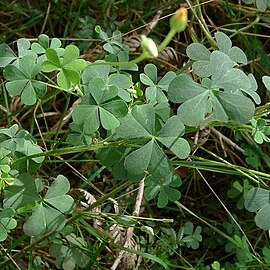Bushy perennial herb, with very stout primary root 3-7 mm wide towards apex. Stems to c. 20 cm long, numerous, slender, mostly erect and suberect, the outer prostrate, glabrate to densely clothed in ± antrorse hairs. Lvs 3-foliolate. Petioles to 5 cm long, glabrate to densely clothed in antrorse hairs; stipules c. 1.5 mm long, nearly completely adnate to petiole, ciliate. Lamina of leaflets equal, subsessile, 3-14 × 1-4 mm, deeply lobed with sinus c. ⅔ length, sometimes purplish, usually ± fishtail-shaped, glabrate or glabrous above, glabrate or with appressed hairs below, ciliate; calli 0. Fls 1-3; peduncles 2-8 cm long, glabrate or with antrorse hairs; pedicels 0.5-1.5 cm long, both much longer at fruiting, glabrate or with antrorse hairs. Bracts 1-2 mm long, linear-subulate, hairy, situated at base of pedicels; calli 0. Sepals 3-4 mm long, ovate-elliptic or elliptic-oblong, with appressed, antrorse hairs; calli 0. Petals > 6 mm long, ± obovate, yellow, glabrous. Stamens at 2 levels, glabrous; filaments united in lower 1/2, those of longer whorl c. 3 mm long. Styles > longer stamens, densely hairy. Capsule 10-20 mm long excluding styles, narrow-cylindric, often falcate but otherwise straight, ± densely clothed in short retrorse hairs. Seeds c. 1.5 mm long, oblong-ellipsoid; transverse ridges (8)-10-11, obtuse; grooves rather shallow.
A herb. It keeps growing from year to year. It can be creeping or curve upwards. It grows 10-20 cm high and spreads 30 cm wide. It has a stout taproot. The stems are slender and there are hairs which point forward. The stems can be 25 cm long. The leaves have 3 leaflets like a clover leaf. But they hang down like a pleated skirt. They are rounded or heart shaped. They are 0.4-1.5 cm long by 0.2-0.8 cm across. The flowers are in the axils of leaves. There are 1-5 flowers in a cluster. The flowers are yellow and 8 mm across. The fruit is a capsule 1-3 cm long by 0.15-0.25 cm wide. It is red and hairy and held above the leaves.

